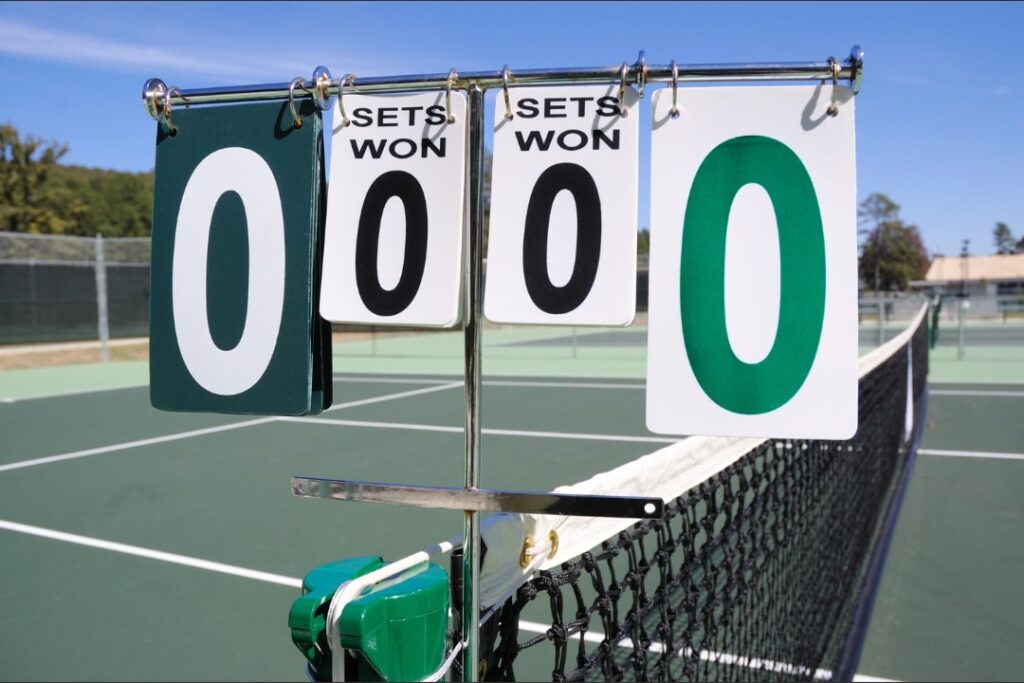If you are new to tennis, you may be confused about some of the terms they use in tennis. One such term is the term “love”, which is used in the tennis scoring system. As an English speaker, you may wonder why “love” is used for tennis scoring.
So, what does love mean in tennis?
In tennis, love is the term used for a score of zero. For example, if the score of a game is 15-0, it is also called 15-love. The term love can also be used to call the scores in sets and tiebreaks, such as 2-love representing a 2-0 set or a tiebreak score.
We are going to see examples of the use of the term love in tennis scoring, the origin of the term love, and more. Read along to know more about love in tennis!
Table of Contents
What Does Love Mean in Tennis Scoring System?

Love in tennis is primarily used to describe a score of zero in the tennis scoring system. Every game starts with 0-0.
The scoring in a tennis game goes from 0-15-30-40.
If, for example, you win the first point of a game from the serving side, then the score becomes 15-love or 15-0.
Here is the full scoring system in a tennis game:
- Love: a score of zero (0)
- 15: a single point
- 30: two points
- 40: three points
- Deuce: tied at 3 points (40-40)
- Ad-in: short for advantage in, when the player serving wins a point at a deuce
- Ad-out: short for advantage out, when the player serving loses a point at a deuce
When to Use Love in Tennis Scoring?
A tennis scoring is structured as follows:
Games -> Sets -> Match
Here are the possible scores in a tennis game with love, assuming you were on the serving side, your score would be called first:
- 15-love, also called 15-0
- 30-love, also called 30-0
- 40-love, also called 40-0
If your opponent was on the serving side and you were receiving, these are the possible scores with love in a game:
- Love-15, also called 0-15
- Love-30, also called 0-30
- Love-40, also called 0-40
A score with love can also be called on a set, although it is more uncommon. For example, if you win three games to zero, the score can be called a three-love.
The term love is also called during tiebreaks. In tiebreaks, the point is counted singularly from 0, 1, 2, and so on instead of the 15-30-40 scoring system. But the same logic still applies.
When the serving player wins the first point of a tiebreak, the score will be 1-love. If the serving player loses the first point of the tiebreak, the score will be love-1.
Love is not used to call the score of a tennis match.
Examples of Tennis Scores with Love
Let’s say player A is playing 2 games against player B.
Player A starts the game as the serving side, with Player B as the receiving side.
The score always begins with 0-0 or love-love, and as the server, player A will always call out their points first.
Here is an example of the game’s scoring:
First game
| Point Outcome | Score (Player A) | Score (Player B) |
| Game begins | 0 (Love) | 0 (Love) |
| Player A wins first point | 15 | 0 (Love) |
| Player A wins second point | 30 | 0 (Love) |
| Player A wins third point | 40 | 0 (Love) |
| Player B wins fourth point | 40 | 15 |
| Player A wins fifth point | Wins the game | Loses the game |
After winning a game, the score of the set becomes 1-0 or 1-love in favor of player A.
Next game 2 starts with player B as the serving side:
Second game
| Point Outcome | Score (Player A) | Score (Player B) |
| Player B wins first point | 0 (Love) | 15 |
| Player B wins second point | 0 (Love) | 30 |
| Player B wins third point | 0 (Love) | 40 |
| Player A wins fourth point | 15 | 40 |
| Player B wins fifth point | Loses the game | Wins the game |
Player B now wins the second game, and the set score becomes 1-1.
As mentioned previously, love can also be called on a tiebreaker scoring point. Here is an example of scoring with love in a best-to-seven tiebreak:
| Point Outcome | Score (Player A) | Score (Player B) |
| Game begins | 0 (Love) | 0 (Love) |
| Player A wins first tiebreak point | 1 | 0 (Love) |
| Player A wins second tiebreak point | 2 | 0 (Love) |
| Player A wins third tiebreak point | 3 | 0 (Love) |
| Player A wins fourth tiebreak point | 4 | 0 (Love) |
| Player A wins fifth tiebreak point | 5 | 0 (Love) |
| Player A wins sixth tiebreak point | 6 | 0 (Love) |
| Player B wins seventh tiebreak point | 6 | 1 |
| Player A wins eight tiebreak point | Wins the tiebreak game | Loses the tiebreak game |
Origin of the Term Love in Tennis: Why Do They Call it Love in Tennis?
There are no official documentation on the origin of the term love in tennis. How the term love came from is still a mystery, but some theories are trying to explain it.
Here are the three theories that suggest where love came from in tennis.
Theory 1: Love as in “Love Of The Game”
The first theory of love in tennis originated from the English word “love”, as in love for the game of tennis.
The deeper meaning is that when a player has not scored in the game, the score shows they are not playing to win but for the “love of the game”.
It makes sense since the tennis rules and scoring system originated in England.
Theory 2: The French Word For Egg – L’oeuf
A second theory believes that the terminology love is an adaptation of the French word l’oeuf, which has a similar pronunciation to “love”.
Furthermore, the word l’oeuf also translates to egg, which has a similar shape to a 0.
The sport tennis was first played by Frenchmen monks, so this can be an acceptable scenario.
Theory 3: Dutch Word for Pride or Honor – Lof
The last theory said that love was based on the Dutch word lof, which again has a similar pronunciation to “love”.
The Dutch word lof translates to pride or honor, which can mean that when a player has not scored any points, he has not earned any praise or honor.
Love-All or Love-Love

Love-all or love-love can be called when the score is zero to zero (0-0), meaning at the start of the game.
In tennis, we use the term “all” to express when the scores of both tennis players are the same.
For example, if the score is tied 15-15, it is also called 15-all. A 30-30 score is called 30-all, and so on.
So, love-all means the score is tied 0-0 or love-love.
However, the term love-all or love-love is rarely used. Usually, in a tennis game, the umpire will call the score when a point has been made. When the game starts and the score is still 0-0, there is no point in calling the scores.
Wrapping up
Tennis has several interesting terms that are used in their scoring system. The term love is a good example.
After reading this article, I hope you are clear about the term love in tennis. So, anytime the umpire mentioned the word, which will be in every tennis game, you will be able to understand.
Related Questions
Why is it Called 15 Love in Tennis?
In tennis, the term love refer to a score of zero. So a 15 love is the same as 15-0, where the serving player wins the first point, while the receiving player has not won any points in the game.
Why is it Called 40 Love in Tennis?
In tennis, the term love refer to a score of zero. So a 40 love is the same as 40-0, where the serving player wins the first three points, while the receiving player has not won any points in the game.
Why is it 40 and not 45 in Tennis Scoring?
The tennis scoring is believed to have originated from the face of a clock, 15-30-45-60. It was initially set that way, but the 45 was shortened to 40 because 45 took too long to say.

